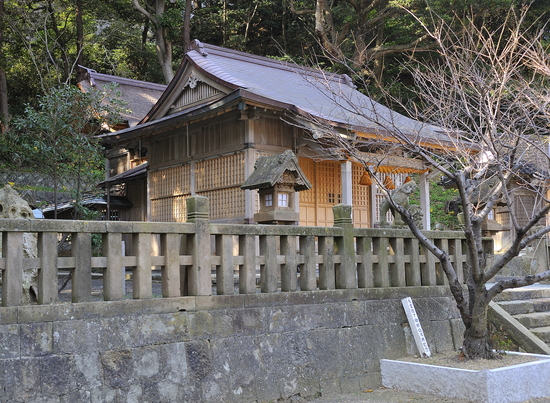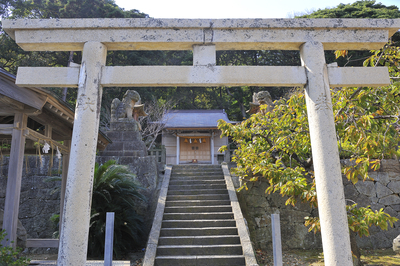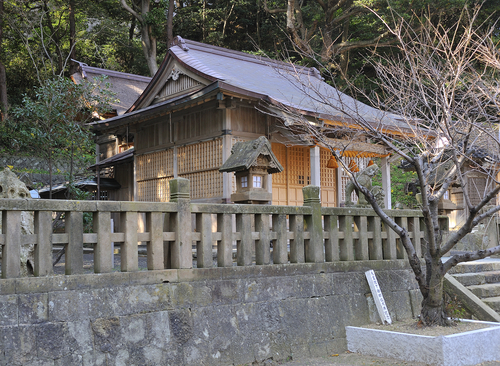Kataku-ura
| Bay Name | Kataku-ura | |
|---|---|---|
| Shrine Name | Hachimangu | |
| Deity |
Emperor Ojin |
|
| Location |
|
Kataku ura Hachimangu
Kimi ga yo wa chiyo no iwao to naru made ni
Kataku mo mamore kami no mikuni o

The character for the shrine location is 'ascend', perhaps due to the 'ascent' between the residential area up to the front of the shrine precinct. Reference to Kataku Bay remains in the publication 'Izumo, Yakka-gun Kataku-ura Folklore Survey' (complied between December 17-22 1939) by folklore historian Miyamoto Tsuneichi. In the document, there are reports of 14 munafuda (wooden plaques) from Hachimangu shrine with written references to dates from the Jokyo era (1684-8) and what looks like inscriptions from the Koji era (1555-8). The munafada also allow an assumption on the frequency with which the main hall of the shrine was restored, this can be put at approximately every 20 years. Visiting the prayer hall today gives us an idea of the faith practiced by the people in this area back in time. Also mentioned in the survey was the 'Forty-two bay Shiokumi' (drawing seawater to make salt process) It was described thus: 'Using a bamboo pipe, one or two scoops of sea water are collected and then taken for blessing at the local shrine. Those making the pilgrimage are kindly taken in by various hosts living around the bays, finally ending up at Ichibata.' The report also spoke of the Kataku landscape; 'One is struck by the scenery ... It looks like most of the pilgrims passing through Kataku stayed at Taishido Temple.' To this day, that temple remains on a mountain road facing the Sata area at a considerable distance from Kataku village. For some reason, Miyamoto failed to acknowledge in his document that his survey was possible thanks to the guidance from Yamamoto Tsunetaro (deceased 1954), well respected by the villagers as 'Yamamoto sensei' , (teacher).

Kataku Hachimangu shrine can be found at the bottom of a cliff on the side of the road nearest the sea by the bus stop after heading east from Tayu. After getting off at the port and heading in a central direction, the Torii shrine gate will come into view.
The Tondo (New Years) festival of Kataku Hachimangu takes place over three days. It involves walking through the town carrying an O-mikoshi ( portable shrine) in the form of the 'Ebisu boat' bearing statues of the gods Toshigami, Ebisu and Daikoku. Everyone gathers at the beach to pray for health and prosperity singing out 'Wakamatsusama'.These days, nearby Katae town's 'Charcoal Tondo' has become popular for its participants covering their faces in black charcoal, but here in Kataku, too, there was a custom for the unmarried women in the town to paint their faces black ahead of praying for prosperity. Nowadays regular locals and visitors alike, regardless of marital status put on the coloring for the event.
Every November, in three locations in the harbor, the Ryujin (dragon god) festival, 'Ringon' is held. A straw boat carrying offerings is cast into the waters to ask the gods for large fishing hauls and safety at sea. While the local specialty seaweed is exceptionally delicious, the turbo and nori seaweed are also caught here.
The Kataku Taishidou temple is located on a mountain top above the Shimane Nuclear Power Plant which is found a little to the east of the Kataku village. Back in the days of the 42 Bay pilgrimage, the Taishidou offered its services as a place of lodging for the travelers. Now it has its own kitchen, where those members of the faith can gather and do their own cooking. The entrance/exit to Taishidou is very close to the entrance of the nuclear power plant. The road approaching the temple has been covered in concrete. This temple is also a simple stop on the Shikoku 88 pilgrimage route with a small shrine present for worship. With its traditional faith and the nuclear power plant, Kataku is a convergence point between old and new civilization.

| Bay Name | Kataku-ura | |
|---|---|---|
| Shrine Name | Hachimangu | |
| Deity |
Emperor Ojin |
|
| Location |
|
Kataku ura Hachimangu
Kimi ga yo wa chiyo no iwao to naru made ni
Kataku mo mamore kami no mikuni o
The character for the shrine location is 'ascend', perhaps due to the 'ascent' between the residential area up to the front of the shrine precinct. Reference to Kataku Bay remains in the publication 'Izumo, Yakka-gun Kataku-ura Folklore Survey' (complied between December 17-22 1939) by folklore historian Miyamoto Tsuneichi. In the document, there are reports of 14 munafuda (wooden plaques) from Hachimangu shrine with written references to dates from the Jokyo era (1684-8) and what looks like inscriptions from the Koji era (1555-8). The munafada also allow an assumption on the frequency with which the main hall of the shrine was restored, this can be put at approximately every 20 years. Visiting the prayer hall today gives us an idea of the faith practiced by the people in this area back in time. Also mentioned in the survey was the 'Forty-two bay Shiokumi' (drawing seawater to make salt process) It was described thus: 'Using a bamboo pipe, one or two scoops of sea water are collected and then taken for blessing at the local shrine. Those making the pilgrimage are kindly taken in by various hosts living around the bays, finally ending up at Ichibata.' The report also spoke of the Kataku landscape; 'One is struck by the scenery ... It looks like most of the pilgrims passing through Kataku stayed at Taishido Temple.' To this day, that temple remains on a mountain road facing the Sata area at a considerable distance from Kataku village. For some reason, Miyamoto failed to acknowledge in his document that his survey was possible thanks to the guidance from Yamamoto Tsunetaro (deceased 1954), well respected by the villagers as 'Yamamoto sensei' , (teacher).
Kataku Hachimangu shrine can be found at the bottom of a cliff on the side of the road nearest the sea by the bus stop after heading east from Tayu. After getting off at the port and heading in a central direction, the Torii shrine gate will come into view.
The Tondo (New Years) festival of Kataku Hachimangu takes place over three days. It involves walking through the town carrying an O-mikoshi ( portable shrine) in the form of the 'Ebisu boat' bearing statues of the gods Toshigami, Ebisu and Daikoku. Everyone gathers at the beach to pray for health and prosperity singing out 'Wakamatsusama'.These days, nearby Katae town's 'Charcoal Tondo' has become popular for its participants covering their faces in black charcoal, but here in Kataku, too, there was a custom for the unmarried women in the town to paint their faces black ahead of praying for prosperity. Nowadays regular locals and visitors alike, regardless of marital status put on the coloring for the event.
Every November, in three locations in the harbor, the Ryujin (dragon god) festival, 'Ringon' is held. A straw boat carrying offerings is cast into the waters to ask the gods for large fishing hauls and safety at sea. While the local specialty seaweed is exceptionally delicious, the turbo and nori seaweed are also caught here.
The Kataku Taishidou temple is located on a mountain top above the Shimane Nuclear Power Plant which is found a little to the east of the Kataku village. Back in the days of the 42 Bay pilgrimage, the Taishidou offered its services as a place of lodging for the travelers. Now it has its own kitchen, where those members of the faith can gather and do their own cooking. The entrance/exit to Taishidou is very close to the entrance of the nuclear power plant. The road approaching the temple has been covered in concrete. This temple is also a simple stop on the Shikoku 88 pilgrimage route with a small shrine present for worship. With its traditional faith and the nuclear power plant, Kataku is a convergence point between old and new civilization.






